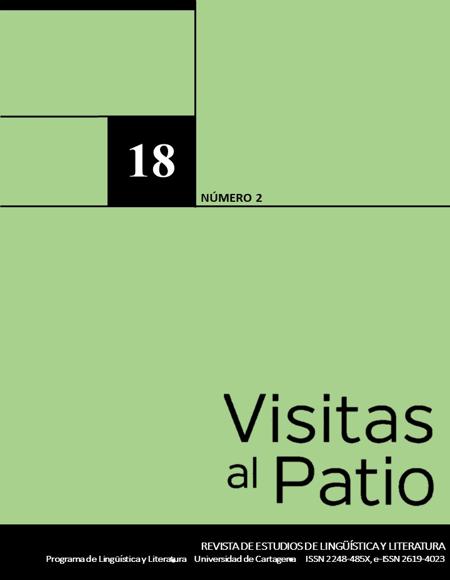Desvíos semánticos: cuando los cambios lingüísticos no ocurren
Semantic Detours. When Linguistic Changes do not Occur
Contenido principal del artículo
Resumen
Descargas
Datos de publicación
Perfil evaluadores/as N/D
Declaraciones de autoría
- Sociedad académica
- Universidad de Cartagena
- Editorial
- Universidad de Cartagena
Detalles del artículo
Referencias (VER)
Bybee, J. (2009). Gramaticalización. Implicaciones para una teoría sobre el lenguaje. En: J. Guo, E. Lieven, S. Ervin-Tripp, N. Budwig, S. Özçalişkan, y K. Nakamura (eds.). Crosslinguistic Approaches to the Psychology of Language: Research in the Tradition of Dan Isaac Slobin (pp. 345- 355). New York: Taylor and Francis Group, LLC. (Traducción de J. A. Ennis)
Bybee, J. (2011). Usage-based theory and grammaticalization. En H. Narrog y B. Heine (eds.). The Oxford Handbook of Grammaticalization (pp. 69-79). Oxford: Oxford University Press. DOI: https://doi.org/10.1093/oxfordhb/9780199586783.013.0006
Bybee, J. (2010). Language, Usage and Cognition. Cambridge: Cambridge University Press. DOI: https://doi.org/10.1017/CBO9780511750526
Bybee, J. y Dahl, Ö. (1989). The creation of tense and aspect systems in the languages of the world. Studies in Language, (13), 51–103. DOI: https://doi.org/10.1075/sl.13.1.03byb
Bybee, J., Perkins, R. y Pagliuca, W. (1994). The evolution of grammar. Tense, Aspect and Modality in the Languages of the World. Chicago: University of Chicago Press.
Comrie, B. (1976). Aspect. Cambridge: Cambridge University Press.
Dahl, Ö. Velupillai, V. (2013). The Perfect. In: Dryer, M. S. y Haspelmath, M. (eds.) WALS Online (v2020.3) [Data set]. Zenodo. https://doi.org/10.5281/zenodo.7385533
Dryer, M. S. y Haspelmath, M. (eds.) (2013). World Atlas of Language Structures (WALS). WALS Online (v2020.3) [Data set]. Zenodo. https://doi.org/10.5281/zenodo.7385533 (Accesible en https://wals.info, accedido el 2023-08-23.)
Drinka, B. (2017). Language Contact in Europe: The Periphrastic Perfect through History. Cambridge: Cambridge University Press. DOI: https://doi.org/10.1017/9781139027694
Evans, V. (2006). Cognitive Linguistics: An Introduction. Edinburgh University Press.
Fløgstad, G. N. (2016). Preterit Expansion and Perfect Demise. A Critical Perspective on Cognitive Grammaticalization Theory. [Brill’s Studies in Historical Linguistics], Brill: Leiden. Open Access. DOI: https://doi.org/10.1163/9789004309081
Fløgstad, G. N. (2017). Revisiting Perfect/Preterit instability across Romance. On functional motivations for diverging paths. Acta Linguistica Hafniensia International Journal of Linguistics, 49(2), pp. 195-211. DOI: https://doi.org/10.1080/03740463.2017.1353200
Fløgstad, G y Rodríguez Louro, C. (2021). Gauging Expansion in Synchrony. The Perfect in 19th Century Rioplatense Spanish. M. Fryd y K. Melum Eide (ed.). The Perfect Volume (pp. 241-258). Amsterdam: John Benjamins Publishing Company. DOI: https://doi.org/10.1075/slcs.217.10flo
Greenberg, J. H. (1969). Some Universals of Grammar with Particular Reference to the Order of Meaningful Elements. En: J. Greenberg (ed.). Universals of Language (pp. 96-104). London: MIT Press.
Haspelmath, M. (2019). Can Cross-Linguistic Regularities be Explained by Constraints on Change? En K. Schmidtke-Bode, N. Levshina, S. Michaelis y I. A. Seržant (eds.). Explanation in Typology: Diachronic Sources, Functional Motivations and the Nature of the Evidence (pp. 1–23). Berlin: Language Science Press.
Hooper, J. B. (1976). An Introduction to Natural Generative Phonology. New York: Academic Press.
Hengeveld, K. (2011). The Grammaticalization of Tense and Aspect. En H. Narrog y B. Heine (eds.). The Oxford Handbook of Grammaticalization (pp. 580-594). Oxford: Oxford University Press. DOI: https://doi.org/10.1093/oxfordhb/9780199586783.013.0047
Howe, C. (2013). The Spanish Perfects. Pathways of Emergent Meaning. [Palgrave Studies in Language Variation]. Basingstoke: Palgrave Macmillan. DOI: https://doi.org/10.1057/9781137029812_3
Howe, C y Rodríguez Louro, C. (2013). Peripheral Envelopes: Spanish Perfects in the Variable Context. En A. M. Carvalho y S. Beaudrie (eds). Proceedings of the 6th International Workshop on Spanish Sociolinguistics (pp 41.52). Cascadilla Proceedings Project.
Langacker, R. W. (1987). Foundations of Cognitive Grammar. Volume I: Theoretical prerequisites. Stanford University Press.
Langacker, R. W. (1991). Foundations of Cognitive Grammar. Volume II: Descriptive application. Stanford University Press.
Lehmann, C. (1995). Thoughts on grammaticalization. Michigan : LINCOM Europa.
Meillet, A. (1912). L’évolution des formes grammaticales. Scientia, 6(12), 130-148.
Norde, M. (2010). Degrammaticalization: three common controversies. En K. Stathi, E. Gehweiler y E. König (eds.). Grammaticalization. Current Views and Issues (pp. 123-150). Amsterdam: John Benjamins. DOI: https://doi.org/10.1075/slcs.119.08nor
Norde, M. (2009). Degrammaticalization. Oxford: Oxford University Press. DOI: https://doi.org/10.1093/acprof:oso/9780199207923.001.0001
Reinöl, U y Casaretto, A. (2018). When grammaticalization does not occur Prosody-syntax mismatches in Indo-Aryan. Diachronica, 35(2), 238-276. DOI: https://doi.org/10.1075/dia.17013.rei
Rodríguez Louro, C. (2013). La referencia indefinida y la expresión de pasado en el español rioplatense argentino (Indefinite reference and past expression in Argentina River Plate Spanish). In L. Colantoni, & C. R. Louro (eds.). Perspectivas teóricas y experimentales sobre el español de la Argentina (Theoretical and experimental perspectives on Argentinian Spanish) (pp. 283-297). Iberoamericana/Vervuert. DOI: https://doi.org/10.31819/9783954871971-018
Rodríguez Louro, C. (2012). Los tiempos de pasado y los complementos adverbiales en el español rioplatense argentino: del siglo XIX al presente. Signo y Seña, (22), 215-234.
Rosemeyer, M. y Grossman, E. (2021). Why don’t grammaticalization pathways always recur? Corpus Linguistics and Linguistic Theory, 17(3), pp. 653-681 DOI: https://doi.org/10.1515/cllt-2020-0053
Slobin, D. I (ed.). (1985). The cross-linguistic study of language acquisition, Vols. 1&2. Hillsdale, N.J.: Lawrence Erlbaum Associates.
Squartini, M y Bertinetto, P. (2000). The Simple and Compound Past in Romance languages. En Dahl, Ö (ed.). Tense and Aspect in the Languages of Europe (pp. 403-439). Berlin/New York: DeGruyter. DOI: https://doi.org/10.1515/9783110197099.3.403
Traugott, E y Trousdale, G. (2013). Constructionalization and Constructional Changes. Oxford: Oxford University Press. DOI: https://doi.org/10.1093/acprof:oso/9780199679898.001.0001
Traugott, E y Dasher, R. (2002). Regularity in Semantic Change. Cambridge: Cambridge University Press. DOI: https://doi.org/10.1017/CBO9780511486500
Traugott, E. (2010). Grammaticalization. En Silvia Luraghi and Vit Bubenik, (eds.). Continuum Companion to Historical Linguistics (pp. 269-283). London: Continuum Press.
Traugott, E y Trousdale, G. (2010). Gradience, Gradualness and Grammaticalization. How do they intersect? En E. Traugott & G. Trousdale (eds.). Gradience, Gradualness and Grammaticalization. [Typological Studies in Language 90] (pp.19-45). Amsterdam: John Benjamins Publishing Company. DOI: https://doi.org/10.1075/tsl.90.04tra



 PDF
PDF
 FLIP
FLIP
 HTML
HTML





